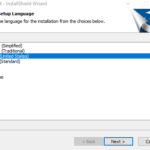In this tutorial, learn how to download and install Kali Linux on VirtualBox for Windows 10/8/7.
Let me explain first what is Kali Linux?
Kali Linux is a Debian-based Linux distribution aimed at advanced Penetration Testing and Security Auditing. Kali contains several hundred tools which are geared towards various information security tasks, such as Security research, Penetration Testing, Reverse Engineering, and Computer Forensics. With over 600 preinstalled penetration-testing programs, it earned a reputation as one of the best-operating systems used for security testing. As a security-testing platform, it is best to install Kali as a VM on VirtualBox.

How To Install Kali Linux in VirtualBox
This post will show how to get Kali Linux on VirtualBox.
How to Install Kali Linux in VirtualBox on Windows 10
Step 1. Install VirtualBox
To begin, you need to download and install VirtualBox from this source. In case you do not have VirtualBox installed, check this step-by-step VirtualBox installation guide.
Step 2. Download Kali Linux ISO Image
You can download Kali Linux .iso images from the Kali Linux Downloads page. Visit this page and look for the packages available for download. Depending on the system you have, download the 32-bit or 64-bit version.
Step 3. Create Kali Linux VirtualBox Container
Once downloaded the .iso image, create a new virtual machine and import Kali as its OS. Here are the steps:
1. Open VirtualBox Manager and then click the New icon.
2. A pop-up window for creating a new VM opens up, enter a name and a destination folder. The Version and Type change automatically, based on the name you enter. Click Next.
Note: The information matches the package you downloaded.
3. Then, select how much memory to allocate to the virtual machine. Click Next.
4. In this dialog box, select “Create a virtual hard disk now” and click Create to continue.
5. On the next screen, select VDI (VirtualBox Disk Image). Click Next to continue.
6. Decide between Dynamically allocated and Fixed size. The first choice enables the new hard disk to grow and fill up space dedicated to it. The second, fixed size, uses the maximum capacity from the start. Click Next.
7. After that, give the name and where you want to store the virtual hard disk. Select the amount of file data the VM is allowed to store on the hard disk. We would recommend you give it at least 30 GB. Click Create to finish.
Now you created a new VM. The VM displays on the list in the VirtualBox Manager.
Step 4. Adjust Virtual Machine Settings
The next step is configuring the default virtual machine settings.
1. Choose a virtual machine, right-click it and click Settings.
2. When the Kali Linux – Settings window appears, go to General > Advanced tab. Change the Shared Clipboard and Drag’n’Drop settings to Bidirectional. This feature enables you to copy and paste between the host and guest machine
3. Then, navigate to System > Motherboard. Set the boot order to start from Optical, followed by Hard Disk. Untick Floppy as it is unnecessary.
4. After that, go to the Processor tab in the same window. Set the number of processors to 2 to enhance performance.
5. Lastly, go to Storage settings. Under Controller: IDE, add the downloaded Kali image to a storage device. Click the disk icon to find the image. Once finished, you can close the Settings window.
6. Now you can click the Start icon to begin installing Kali.
Step 5. Installing & Setting Up Kali Linux
After clicking Start icon, a new VM VirtualBox window occurs with the Kali welcome screen. Select the Graphical install option and go through the following installation steps for setting up Kali Linux in VirtualBox.
1. Choose a language: Select the default language for the system.
2. Choose your location: Locate and choose your country from the list (or select “other”).
3. Configure the keyboard: Decide which keymap to use. Normally, we select American English
4. Configure the network: Give a hostname for the system and click Continue. Then create a domain name (the part of your internet address after your hostname). Domain names usually end in .net, .com, .edu, and more.
5. Set up users and passwords: Give a strong root password for the system administrator account.
6. Configure the clock: Choose your time zone from the available options.
7. Partition disks: Choose how you would like to partition the hard disk. Select Guided –use entire disk option.
8. Next, choose which disk you want to use for partitioning. As you created a single virtual hard disk in Step 4. Configure VM Settings, you do not have to worry about data loss. Choose the only available option – SCSI3 (0,0,0) (sda) – 68.7 GB ATA VBOK HARDDISK (the details after the dash vary depending on your virtualization software).
9. Moving on, choose the scheme for partitioning. If you are a new user, select All files in one partition.
10. The wizard provides you an overview of the configured partitions. Continue by going to Finish partitioning and write changes to disk. Click Continue and confirm with Yes.
11. The wizard starts installing Kali. While the installation bar loads, additional configuration settings occur.
12. Configure the package manager. Choose whether you want to use a network mirror and click Continue. Type the HTTP proxy information if you are using one. Or you can leave the field blank and click Continue again.
13. Install the GRUB boot loader on a hard disk. Choose Yes and click Continue. Then, choose a boot loader device to ensure the newly installed system is bootable.
14. Once you see the message Installation is complete, click Continue to reboot your VM.
Now, you have successfully installed Kali Linux on VirtualBox. After rebooting, the Kali login screen appears. Type in a username (root) and password you entered in the previous steps.
Finally, the interface of Kali Linux appears on your screen. After rebooting, the Kali login screen occurs. Enter a username (root) and password you entered in the previous steps.
We have a video tutorial for installing Kali Linux in VirtualBox on Windows 10:
With this tutorial, you have learned how to install Kali Linux on VirtualBox. Hope something helps you.






